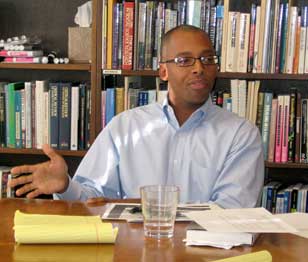An IU professor gives a talk on his new book 'The Condemnation of Blackness'
Indiana University Assistant Professor of History Khalil Muhammad, discussed his recent book, The Condemnation of Blackness: Race, Crime, and the Making of Modern Urban America (Harvard University Press, 2010), at a Poynter Center Roundtable Oct. 5.

Khalil Muhammad
The Roundtable series highlights creative work and research by IU Bloomington faculty in ethics and democratic life and culture. Muhammad -- who is also associate editor of the Journal of American History -- discussed his book, which is a story about the evolution of the idea of black criminality and its ties to the making of modern urban America.
In The Condemnation of Blackness, Muhammad asks what factors have conspired to construct Americans' perception of criminality around blackness? With the 1890 census -- the first to measure the generation of blacks born after Emancipation -- crime statistics were deployed as scientific "color-blind" data to feed a cautionary tale about the exceptional danger posed by black Americans to urban society. Muhammad's book reconstructs key moments, beginning one generation after slavery, when such statistical data were connected to wider debates about the place of African Americans in urban America.
The author focuses in particular on these debates in northern cities and the northern criminal justice system -- areas that have been relatively neglected in the historical scholarship regarding crime and race in America. This racialization of criminality, he shows, evolved over four decades and, in the process, shaped the public transcript of the modern urban world in a wide range of spheres -- from education to jobs, to concerns about public safety.
On page five of his book, Muhammad writes: "At the dawn of the twentieth century, in a rapidly industrializing, urbanizing, and demographically shifting America, blackness was refashioned through crime statistics. It became a stable racial category in opposition to whiteness through racial criminalization. Consequently, white criminality lost its fearsomeness. With the publication of the 1890 census, prison statistics for the first time became the basis of a national discussion about blacks as a distinct and dangerous criminal population. In the wake of the Civil War and Reconstruction, when the culture and politics of white supremacy in the South and across the nation were being reconstituted, African American freedom fueled far-reaching anxieties among white Americans. This book asks, among other questions: how did European immigrants - the Irish and the Italians and the Polish, for example - gradually shed their criminal identities while blacks did not? In other words, how did criminality go from plural to singular?".
This crucial period in U.S. history, Muhammad argues, helped shape the landscape of urban America and the politics of crime and punishment today.